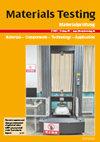用于生物可降解植入物的二元 Mg-3Zn 新型杂化复合材料的摩擦学和电化学腐蚀行为
IF 2.4
4区 材料科学
Q2 MATERIALS SCIENCE, CHARACTERIZATION & TESTING
引用次数: 0
摘要
本研究工作的重点是分析在 Mg-3Zn 合金基体中引入新型金属/生物陶瓷(Ti/HA)化合物对摩擦学和腐蚀的影响。混合复合材料采用挤压铸造法研制。对所开发复合材料的密度、显微硬度和显微结构进行了检测。在磷酸盐缓冲盐水(PBS)润滑介质下,使用针盘摩擦学测试仪进行了摩擦学研究。在 PBS 介质中进行了电化学腐蚀研究。在 Mg-3Zn 合金基体中加入混合 Ti/HA 颗粒可显著提高复合材料的密度和显微硬度。光学显微镜分析表明,增强颗粒的晶粒尺寸细化、分布均匀,结构完整性得到改善。扫描电子显微镜分析进一步证实了 α-Mg 和 β-Mg-Zn 相。磨损测试结果表明,Mg-3Zn(MZ0)基体中含有的 Ti/HA 增加了耐磨性。在磨损表面观察到了磨损、分层、氧化层形成和严重的分层特征。磨料磨损与所有其他磨损机制同时发生,是磨损的诱发因素。电位极化实验表明,加入 1.5% 的 HA 后,混合复合材料的耐腐蚀性能得到了提高。本文章由计算机程序翻译,如有差异,请以英文原文为准。
Tribological and electrochemical corrosion behavior of binary Mg–3Zn novel hybrid composites for biodegradable implant applications
The present research work is focused on analyzing the tribological and corrosion impacts of introducing a new metal/bioceramic (Ti/HA) compound into the matrix of the Mg–3Zn alloy. The hybrid composites were developed using the squeeze casting method. The density, microhardness, and microstructure of the developed composite materials were examined. A pin-on-disk tribology meter was used to conduct the tribological study under a phosphate-buffered saline (PBS) lubricating medium. Studies on electrochemical corrosion were carried out in the PBS medium. Incorporating hybrid Ti/HA particles into the Mg–3Zn alloy matrix significantly increased the density and microhardness of the composites. Optical microscopy demonstrates a refined grain size and uniform distribution of reinforced particles, showcasing improved structural integrity. Scanning electron microscopy analysis further confirms the α-Mg and β-Mg–Zn phases. According to the findings of wear tests, the Ti/HA inclusion in the Mg–3Zn (MZ0) matrix increased the resistance to wear behavior. Abrasion, delamination, oxide layer formation, and severe delamination features were observed at the worn surfaces. Abrasive wear happened along with all other wear mechanisms and served as a wear initiator. Potentiodynamic polarization experiments revealed that the corrosion resistance of hybrid composites was increased with the inclusion of 1.5 % HA.
求助全文
通过发布文献求助,成功后即可免费获取论文全文。
去求助
来源期刊

Materials Testing
工程技术-材料科学:表征与测试
CiteScore
4.20
自引率
36.00%
发文量
165
审稿时长
4-8 weeks
期刊介绍:
Materials Testing is a SCI-listed English language journal dealing with all aspects of material and component testing with a special focus on transfer between laboratory research into industrial application. The journal provides first-hand information on non-destructive, destructive, optical, physical and chemical test procedures. It contains exclusive articles which are peer-reviewed applying respectively high international quality criterions.
 求助内容:
求助内容: 应助结果提醒方式:
应助结果提醒方式:


